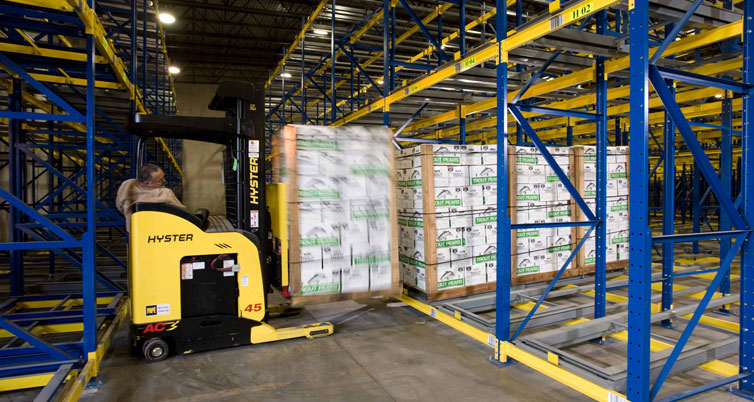We would like to address the issue of slope in push back rack systems as there has been much talk in the industry in regards to push force and benefits of low slope.
Our unique low profile push back system was developed in 1992, and at that time one of the design features we decided on was to slope our rails at 3/8” per foot so that there would only be 2 interior beam types – a flush top and a drop 1.5”. The slope we chose had nothing to do with the performance of our carts.
Furthermore we would like to add that the slope is “free” – since we are not lifting up a pallet at the back of the lane, we only need clearance at the load/unload end. Having a bit more slope does not cost us an additional level and/or leave us with less clearance from level to level.
That being said, having the slope at 3/8” per foot has several other advantages:
- First and foremost is empty cart return. Our carts always return to the front in an empty state no matter how old the system is. Several of our competitors who use either C channel rails or I beam rails in combination with lower slope have problems with this issue. With our system, if an operator comes in too low with a pallet and moves the carts to the back of the lane, all he has to do is lift the pallet up and the empty carts will roll to the front and he can load the lane properly. Competitive systems that do not have consistent empty cart return (especially as they age and have collected dust) may require the forklift operator to go and get a scissor lift or extended forks to reach back in the lane and bring the carts forward – an obvious time waster.
- Secondly, because our pushback racks have a little more slope, the carts/loads will follow the operator more quickly when he unloads a lane, thus not forcing him to inch his way backwards at a slow pace.
- The additional slope reduces the amount of inadvertent hang-ups caused by misplaced loads leaning against frames, dangling stretch wrap, etc. More slope means a little more return force to bring the pallets back to the load end. Because we link our carts, we don’t have to worry about a single pallet being hung up at the back of the lane and racing forward to the front – unlike some of our competitors.
There have been some discussions within the fork-lift industry as to the push forces required in pushback racking and the resultant engineering concerns. 3D has over 10,000 push back racking installations worldwide with every type of forklift. We also work closely with the engineering departments of several lift truck manufacturers to examine the issues and ensure that systems are safe and the forces are not excessive for the forklift. If you have any specific truck and/or application where you have a concern, we would be happy to find you several references from end-users who are using the same type of truck in a similar application.
Finally, we would like to add that we can install our push back racking system at a lower slope if all of the above has not convinced you that it is not necessary. In fact, because our carts ride on a flat, smooth, cold rolled steel surface with a 1” wide steel wheel, they actually roll better than our competitors carts which ride on an angled surface which has a rougher finish because it is a hot rolled section.
Our current slope of 3/8” per foot results in a push force of 4% of the loads being pushed back (in a 4 deep with 2500#, that results in 4% of 7500# or 300#). At 1/4” per foot that force is reduced by roughly half. We have installed a few pushback systems at this lower slope, but in all cases these were for customers who wanted to case pick from pallets and have operators manually remove pallets from the pushback lane.

